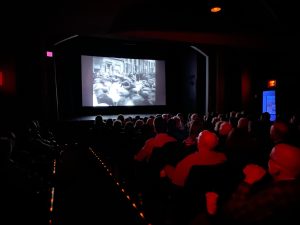Digital Joy Engage Helps Boost Revenue + Engagement for Local TV Broadcasters
Executive Summary
KGET is a local news station in Bakersfield, California, that was facing issues familiar to any modern news outlet: a stagnant production budget, viewer disconnect, and competition with OTT providers and internet news.
That’s when KGET General Manager Derek Jeffery decided on an innovative new approach to daily newscasts: live opinion polling on air using Digital Joy Engage software. He also made the brilliant decision to sell sponsorship of the polls – seen twice an hour by 50,000+ viewers – to local Bakersfield businesses. “It’s sold since day one,” Jeffery’s said
The result?
- A new ad revenue stream that has sold since day one
- Increased viewer engagement with 1,000+ respondents on every poll
- Invaluable insights for the KGET editorial team about what their audience cares about most
- A deeper connection to the community where viewers have a role in the news and feel heard
Read more about how Digital Joy Engage live polling helped KGET local news have major successes in revenue, engagement, and connection – and how it can do the same for you.
Local Broadcaster Boosting Revenue through Engagement Technology
Intro
The importance of local television news to television station groups and the community is difficult to overstate. According to the Pew Research Center, 86% of Americans tune into local television news regularly.1 Revenue from advertising during news before, during, and immediately after local news broadcasts are an important source of revenue for television stations and station groups, making it crucial for newscasts to be engaging and inclusive.
More stories that touch more communities have been the preferred approach of newsroom leadership, but that’s not always possible. While the importance of local news to broadcast television economics has grown, production budgets have remained relatively flat. Today broadcasters rely on three legs of engagement – the live linear broadcast, OTT/digital, and social media. Building their digital infrastructure has also taken a large share of resources.
While social media efforts can successfully drive traffic to local station websites, it remains challenging to monetize that audience. The evening live broadcast remains the economic heart of local television news operations.
Local TV news shines in crisis. But it must be a better and more relevant day in and day out, say industry analysts. Some newsroom leaders are… trying to develop innovative approaches to daily newscasts, but those efforts are not yet permeating the industry.2
Opinion polling as an engagement and monetization tool
One news leader looking for innovative approaches to daily newscasts is General Manager Derek Jeffery of KGET in Bakersfield, California. His decision to include opinion polling in the newscasts has increased viewer engagement and unlocked a new revenue opportunity. KGET offers advertisers the option of sponsoring the daily poll.
“Every time we ask a question, we get no less than 1000 respondents, which is larger than the pool of other polling done in the market. Advertisers love it because they know there are 50,000 people watching and seeing their logo and then then the 1000+ respondents per day who follow it to their social media or desktop when they answer the question.” says Jeffery. “it has been sold since day one. The way we position it is the strongest real estate they can get. It’s not preemptible, and it sits on the screen four times an hour through a two-hour newscast.”
While some advertisers might balk at associating their brand with potentially controversial topics, Jeffery has found that not to be true in the Bakersfield business community. “Local businesses understand that their ads may follow unpleasant stories, “ says Jeffery. “But supporting the community is important to them. They did not mind their brands being associated with tough issues.”
KGET’s polling adds a local angle to national stories. People have a natural curiosity about where their neighbors stand on issues.
To maintain sponsors’ and viewers’ confidence in polls, adhere to best practices:
- Do not ask leading questions and be as objective as possible.
- Avoid jumping to conclusions not supported by data. Polls tell us what proportion of a population has a specific point of view, but do not explain why they have that view.
- Understand that polling data represents public opinion at a point in time. Polling data can age quickly.
Polling is not only of interest to the audience. The KGET editorial team gets insights from poll results to help them understand which issues are most important to their audience, and how strongly the community feels one way or the other. Most importantly, KGET has built a connection to the community by listening – a two-way communication that is often difficult to achieve between a broadcaster and its audience. Asking the audience members to share their opinions builds a deeper connection, giving them a role in the nightly newscast.
Gaming engagement
Gamification is the use of popular gaming elements to encourage desired behaviors, and over the past decade, it has been widely adopted by marketers. It takes the things that make games popular – points, higher levels, competition, and the pride in winning – and uses them to encourage the desired behavior. SnapChat is an example of gamification. Users are granted points equal to the number of successive days they exchange Snaps with another user. The points are the only reward. Users cannot exchange points for something tangible, yet maintaining their streak tallies keeps them coming back day after day.
The brain releases dopamine when we achieve a goal. Dopamine triggers the pleasure center of our brains. That helps explain why it feels good to complete Wordle in three attempts, sink a basket, or hit a 90+ MPH fastball 411 feet.
Following the success of KGET’s polls, General Manager Derek Jeffery wanted to encourage deeper engagement and motivate people to pay closer attention to the station’s newscasts. He began experimenting with quizzes. Asking viewers questions about recent news events covered by KGET and scoring them on the number of right answers provided made watching the news fun, engaging, and habit-forming.
“In 2022, people are faster to react and engage… responses are only increasing. Other traditional census polling in the area don’t get the interaction we get in one of our newscasts.” says Jeffery
During the 2020 election season, KGET’s quizzes were more than entertaining. The post-Presidential Debate Quizzes asked viewers to attribute quotes to the correct candidate. The pre-Election Day quiz asked the audience to attribute positions taken to each candidate. Answers to those questions required detailed knowledge of the candidates’ positions. KGET’s gamification rewarded participants for being informed voters. Other popular current events quizzes and quiz shows such as NPR’s “Wait, Wait, Don’t Tell Me” tend to focus on news oddities while KGET focuses on issues of local and national importance.
Getting started
Tools from Google and Survey Monkey make it easy to create an online poll, but neither was designed with the live video event in mind. KGET uses Digital Joy Engage, part of the full Digital Joy media production platform. Purpose-built for live presentations, the production team loads its graphic assets to Engage once. From that point on all polls and quizzes are properly branded. This allows the producer to focus on the content. Questions can be entered in real-time as events unfold, so they are always timely.
When viewers are asked about audience polling, they usually think of American Idol or other high profile “shiny floor” programs. Digital Joy Founder and President Tracey Shaw, encourages broader use of audience interaction. “KGET is the pulse of the community. They know what their viewers are interested in, and they listen. They are providing the news that is important to them. “ says Shaw “This kind of engagement is used in everything from classrooms to houses of worship to corporate meetings to government forums. Listening to your audience and keeping them involved is key to any industry.”
Though Digital Joy is a complete, end-to-end video production platform, the Engage module can be deployed as a standalone solution to augment any production. Because it is a fully cloud-native SaaS (Software as a Service) product, there is no upfront hardware expenditure. The customer only pays for what they need.
Conclusion
Trust is a crucial component of any media production. Seeking real-time feedback from your audience and making them active contributors to the program’s content stream tells audience members they are respected and their opinion matters. With no upfront costs, it is possible to experiment as KGET did and find the use cases and formats that work for your needs.
To learn more about Digital Joy Engagement Technology please visit www.digitaljoy.media or email Tracey Shaw, Founder and President at tracey@digitaljoy.media

